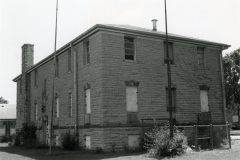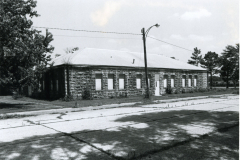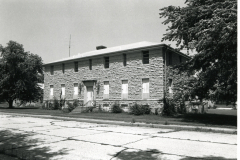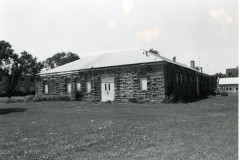| Address: | Choctaw and Comanche, and Creek and Cherokee Streets, Chilocco, Oklahoma | County | Kay |
| Started: | 1938 | Completed | 1941 |
| Agencies: | WPA | NRHP: | September 9, 2006 |
Current Usage
Law Enforcement practice and training grounds.[4]
Description:
The Chilocco Indian School Campus consists of two WPA buildings: The Government Employees Quarters Building and the Chilocco Print Shop. The Government Employees Ouarters Building is a two-story, rectangular (71′ x 35′) structure constructed of rusticated and cut native stone arranged in a random coursed ashier pattern. The roof is hipped with new shingles, and a chimney is located at the northeast corner. The single entry west doorway is framed by stone pilasters on the sides and a stone awning above. Window openings, presently filled with plywood boards, rise from stone slip sills and reach to the eaves. The structure retains its architectural integrity.
The Chilocco Print Shoip is a one-story, rectangular (90′ x 64′) structure constructed of cut native stone. The stone is laid in a random coursed ashier pattern with the lower half of the walls rusticated. The roof is hipped and contains new shingles. The single entry on the west is reached by one concrete step. Now boarded over, single placed window openings utilize stone lug sills. The building’s integrity has not been impeached.
Chilocco was one of the principal boarding schools operated for Native Americans in the United States and attracted Indian youngsters from across the nation. Its curriculum emphasized vocational training, with its most successful program being the training of print shop personnel. The school published a monthly magazine that circulated throughout the United States. Given the importance of Chilocco as an educatinal institution in the 1920s and 1930s, BIA and other government employees frequently visited the facility, but because of its isolation had no place to stay. The Quarters Building addressed that problem and symbolized the significance of Chilocco as a national institution. The Print Shop suggested the school’s vocational emphasis and illustrated its national reputation in the field of Indian journalism. Both buildings, therefore, are exceptionally significant because of their relationship to Indian education. They are also exceptional in that they were built for a federal agency, the Bureau of Indian Affairs, and by a labor force drawn primarily from Oklahoma’s Indian population. WPA structures built by the government for the government with Indian labor are rare! Architectural style, type and materials also make them unique within the community. The two helped revitalize the depressed economy of northern Oklahoma and southern Kansas in that construction of them provided wages from nearly 58,000 man-hours of labor that were spent locally. Given useful work and a paycheck, laborers salvaged their pride and prevented their family’s further impoverishment. [1]
VERBAL BOUNDARY DESCRIPTION: From the intersection of Choctaw and Commanche Streets, go 98 feet north to a point of beginning, then 80 feet east, 90 feet north, 80 feet west, and 90 feet south to the point of beginning; then go 54 feet north from the northwest corner of the above described tract to a p.o.b., then 50 feet east, 75 feet north, 50 feet west, and 75 feet south to the p.o.b.
The whole Indian School Campus is listed in the National Register of Historic Places.[2]
Sources:
- Oklahoma Landmarks Inventory Nomination
- National Register of Historic Places
- Wikipedia Article on School
- Abandond Oklahoma.com
Supported Documents:
- WPA Properties Kay County – Chilocco Indian School
- National Register of Historic Places Support Document
- National Register of Historic Places Nomination Form







Leave a Reply